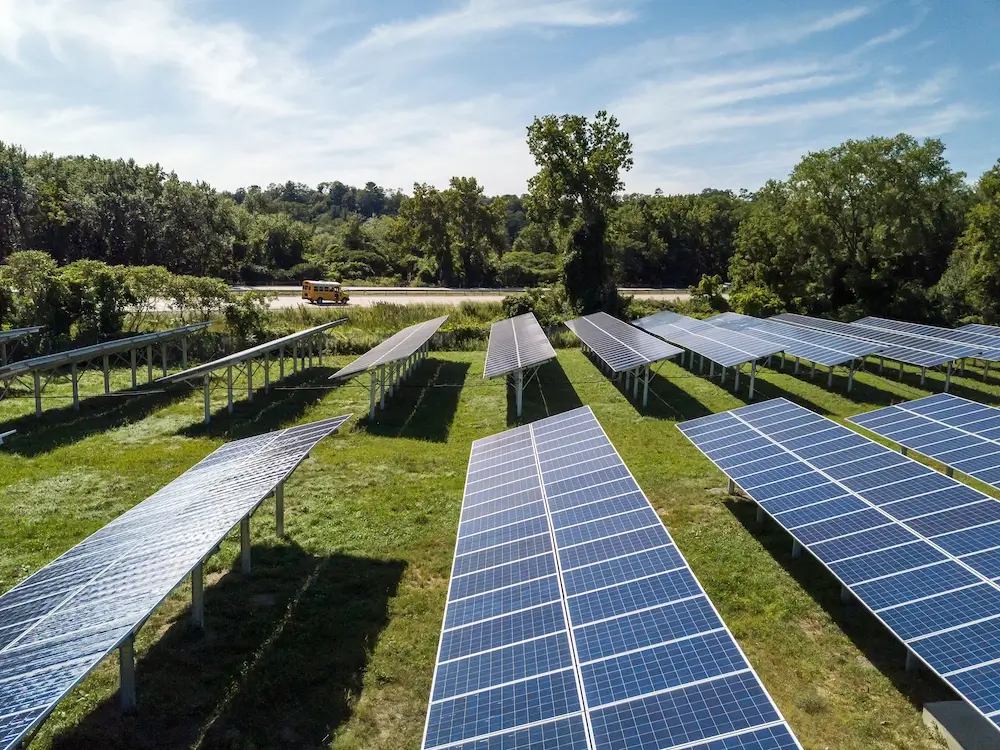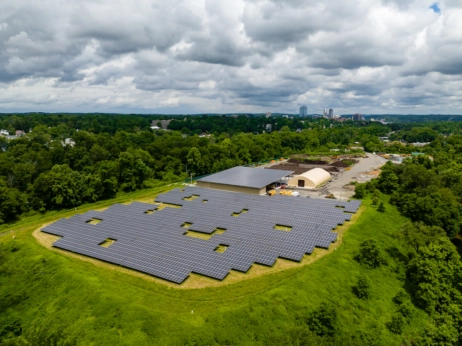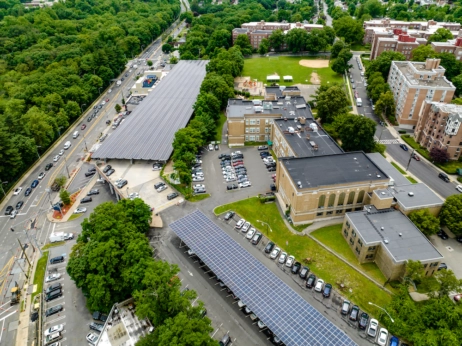Community solar provides an option for whole communities to share in the benefits of locally generated clean energy together.

Across the US, solar is booming. Last year saw nearly 33 gigawatts of solar installation across the country, a 55-percent jump from 2022. Utility-scale solar grew particularly quickly, with an 86-percent year-on-year increase.
This breakneck pace is great news for the nation’s mission to transition to more clean energy generation, especially as precipitous cost curves make it increasingly affordable to decarbonize. But the reliance on utility-scale solar, which requires hundreds to even thousands of acres of land for panel installations, has sparked questions regarding the magnitude of land use requirements. In addition to concerns about impacts on food production and sensitive ecosystems, some critics argue that converting thousands of acres of agricultural land to utility-scale solar arrays would compromise the character of rural regions.
Community solar, in contrast, operates at a small enough scale that it can occupy land within rural communities, such as commercial rooftops and brownfield sites, that might otherwise go unused—thus preserving the bucolic nature of agricultural regions. Plus, it enables households and business owners within rural areas, farmers and non-farmers alike, to benefit from renewable energy.
Community solar: the Goldilocks of renewables
Historically, would-be solar energy supporters have faced a binary between utility-scale solar, where large projects of typically five or more megawatts (MW) deliver electricity directly to a utility’s electric grid, and rooftop photovoltaics, where individual households or businesses generate up to one MW of solar energy through leased or purchased panels.
Between these two extremes sits community solar, a rapidly expanding midpoint promoted by recent legislation across many US states. Usually generating up to five MW of energy, community solar projects are small facilities, occupying up to 25 to 35 (and often more like five to 10) acres. Each megawatt powers the equivalent of 164 homes.

A solar project located at Gedney Landfill in White Plains, NY. (Photo credit: DSD Renewables)
Anyone living in the utility territory who pays an electric bill—from rural farms to urban apartments to businesses of all sizes, houses of worship and nonprofits—can subscribe to the community solar farm and receive a discount off their electricity bill, typically between five and 20 percent depending on the state.
Instead of one solar array built on the rooftop of a single-family home, community solar provides an option for entire communities to share in the benefits of locally generated clean energy together. And unlike utility-scale solar, where ratepayers finance large solar projects via new line items on their utility bills but do not necessarily see the savings, community solar subscribers directly benefit from solar savings—similar to how a home-owned array benefits an individual household. In addition, a community solar subscription provides flexibility: no sign-up fees, no cancellation penalties and the ability for a subscription to follow the user’s utility account to a new home if they move.
Perhaps the best thing about community solar is its effectiveness as a tangible option for people to participate in and take advantage of our country’s transition to renewable energy. More than a third of American households rent their homes, and for those who are homeowners, many lack the right sunny conditions on their property or simply can’t afford the long-term investment in solar panels. Community solar bridges the gap between utility scale and rooftop solar projects, keeping more money in people’s hands.

Solar panels atop the Shapham Place parking lot in White Plains, NY. (Photo credit: DSD Renewables)
The clean energy cover crop
Importantly for farmers and other rural residents, community solar helps rural areas meet their energy goals without an outsized impact on local landscapes. Community solar fits neatly into the nooks and crannies of a community and doesn’t require the large acreage of a utility-scale array installation.
You can think of community solar as a multi-benefit “cover crop” for land that might otherwise go unused. Just as a farmer might grow alfalfa as a cover crop on a fallow field, communities can install solar on a school’s rooftop, a parking lot, a brownfield site too expensive to remediate or on agrivoltaic-compatible land such as cranberry bogs or sheep pastures. And just as alfalfa fixes nitrogen, builds soil, fights erosion and feeds livestock, community solar lowers energy costs, can make the local electric grid more reliable and brings money and jobs through labor and income, such as farmland leases, to the area.
With community solar, farmers save on their energy bills, property owners earn monthly rent for hosting panels, school children experience field trips to learn about solar generation and the municipality progresses towards its clean energy goals. Community solar is the third alternative that helps agricultural communities make efficient use of their land without sacrificing the farms or natural features that make the area special.

Photo credit: DSD Renewables
Sunlight isn’t red or blue, it’s ultraviolet
Growth in community solar ties into clean energy’s larger shift from politically divisive, abstract discussions about climate change to more nonpartisan, financial pragmatism. Recent meteorological events, such as the Canadian wildfire smoke, the Midwestern polar vortex and San Diego’s flooding, have spurred more conversations around the need to prepare for extreme weather, no matter what causes it. Given the energy transition’s potential to boost climate resilience, people are also discussing the role of renewables, such as solar and wind, within our nation’s generation stacks. This shift from political to financial perspectives makes clean energy a frequently purple endeavor, supported by the fact that both red and blue states are looking for ways to open or expand community solar as an option.
How does community solar fit farmers’ needs? Because of their large energy consumption at a more expensive residential rate, energy costs for farmers are often disproportionately higher in their operating expenses compared to other business types. Consequently, representatives from rural and agricultural areas are often community solar’s biggest supporters. Farmers looking to boost their resilience to extreme weather events by building a financial cushion can look to utility savings or solar leases as a significant benefit.
People interested in community solar can do a quick search online to see what kind of subscriptions are available in their area. As of December 2022, community solar projects are located in 43 states, plus Washington, D.C. To lease some of their land, people could contact community solar developers about opportunities to host solar projects. Other ways to take action include writing to elected officials to express support for the introduction or expansion of community solar programs, depending on the state’s current legislation, and spreading the word about community solar’s potential to neighbors and peers.
Whatever kind of community you find yourself in, community solar is or may soon be a neighbor—and a good neighbor, too.
Bruce Stewart is President and CEO of Perch Energy, a Boston-based company focused on accelerating access to community solar nationwide. Bruce has 30+ years of experience leading both energy and technology companies, serving as president of Direct Energy Home, co-president of Centrica US Holdings, and executive positions at GE Current and Constellation Energy. He is committed to Perch’s mission of making cleaner energy options more accessible for all.
Thank you for this excellent opinion piece. I practice land use law in New York’s Hudson Valley where there is still a lack of understanding on the difference between community solar which provides substantial benefits to the local agricultural community and the large utility scale facilities being located in other areas of NYS. Opinion pieces such as this that set the facts straight are much needed and much appreciated!
Funny how most of the community solar projects in my state generate electricity to be sold in neighboring states versus locally….then, I read that the author runs a company that builds these “community” projects. Never ask a barber if you need a haircut.